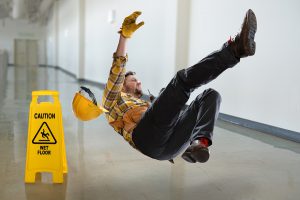Proving Your Case After A Slip And Fall Accident
 Michael Babboni
Premises Liability
Slip and fall accidents can cause a myriad of different injuries. If you’re lucky, the slip and fall may only cause a light sprain, a couple of bruises, or a scratch…but not everyone has this type of luck. Slip and fall accidents may also cause breaks, severe sprains and strains, and even traumatic brain injuries, and you’ll need to prove quite a bit if you expect to be compensated for your various damages. Liability is the single most important key issue in slip and fall accident cases, and you will not just have to prove that you were hurt, but that your injuries were caused by another party’s negligence.
Michael Babboni
Premises Liability
Slip and fall accidents can cause a myriad of different injuries. If you’re lucky, the slip and fall may only cause a light sprain, a couple of bruises, or a scratch…but not everyone has this type of luck. Slip and fall accidents may also cause breaks, severe sprains and strains, and even traumatic brain injuries, and you’ll need to prove quite a bit if you expect to be compensated for your various damages. Liability is the single most important key issue in slip and fall accident cases, and you will not just have to prove that you were hurt, but that your injuries were caused by another party’s negligence.After a slip and fall accident, there are 2 key questions you’ll need to ask yourself. The first question has to do with who the potentially liable parties may be, and the second is if they were actually negligent in causing your accident. This negligence doesn’t need to be something blatantly obvious, like something a person actively did, and often falls into the category of what they didn’t do. A set of stairs weren’t repaired, debris was not cleaned up, or a hazard was not clearly marked are a few common scenarios where one will find negligence in a slip and fall.
What Injured Parties Will Need To Prove
The most important thing an injured person will need to prove in their case is what the liable party either did or did not do that lead to their accident. The liable party will typically be the owner of the property, and the injured person may need to prove that this party did not recognize a dangerous condition like an uneven walking surface or hole, they did not remove or repair a danger, or they did not clearly mark hazardous areas. In order to be held liable, the property owner must be facing a hazard that a reasonable person would have identified and had a reasonable amount of time to repair, notify, or remove.
In some instances, it can be something the property owner themselves does that creates the hazard. For instance, leaving debris along walking paths unmarked is a negligent action that creates a dangerous situation for any visitors to the property. For example, if an electric cleaning instrument is left in the aisle of a store with the cord cutting across the path, and a visitor trips and falls on that cord, this could fall into this negligent action category.
Proving You Did Not Cause Your Own Accident
When proving your slip and fall case, you not only need to prove that the liable party was negligent, you need to prove that you were not. Contributing to your own accident with your own negligence can lessen your settlement or have your case thrown out altogether, leaving you responsible for part or all of your accident related damages.
In order to prove that you did not cause your own accident there are a few questions you’ll need to answer. First and foremost, you’ll need to prove that you were not engaging in any activity that prevented you from noticing any hazards, and that your full attention was on your surroundings. Next, you’ll need to prove that you had lawful access to a particular occasion and were allowed to be there the time of the accident. Lastly, you’ll need to be able to prove that there was no signage or warning about the hazard that caused your accident.
If you were in a slip and fall accident and need guidance in representing your case, contact us at TheStPeteLawyer.com today.
